Can Joe Johnson help Heat win? What's his possible impact?
— -- Editor's note: This story was updated after news broke that Joe Johnson was likely to sign with Miami.
A relatively quiet buyout market heated up Thursday, when the Brooklyn Nets and Joe Johnson agreed to a deal that makes the seven-time All-Star an unrestricted free agent in advance of the stretch run.
On Friday, ESPN's Zach Lowe reported that the Miami Heat expect to sign Johnson when he clears waivers Saturday. Of course, Miami won't be getting the high-scoring shooting guard who averaged better than 20 points per game each of his first five seasons with the Hawks (2005-06 through 2009-10). At 34, does Johnson still have something left to offer the Heat?
Spot-up Joe replaces Iso Joe
In his prime, Johnson earned the nickname "Iso Joe" for his preferred form of scoring -- creating his own shot out of isolation plays. In both 2008-09 and 2009-10, Johnson was one of the league's five leading scorers on isolations, according to Synergy Sports tracking.
Those days are long gone. This season, per Synergy tracking available on NBA.com/Stats, Johnson has shot just 34.8 percent on isolation plays.
More broadly, Johnson is no longer capable of creating his own shot like he once did. Johnson's usage rate declined to 17.9 percent of Brooklyn's plays, his lowest mark since he was a rookie. When he has tried to create his own shot, Johnson has struggled. Most of his unassisted attempts come inside the arc and Johnson is shooting just 42.7 percent on 2-point attempts, down from 47.2 percent last season.
In some ways, however, Johnson's decline has made him a better fit for a contending team. Miami has guards Goran Dragic and Dwyane Wade to create offense. Johnson will fit into a role spacing the floor. And he can still be effective there. Over the course of the season, Johnson is shooting 37.1 percent from beyond the arc, right at his career mark.
Besides spotting up, Johnson can still take advantage of his size in the post against smaller defenders. According to Synergy tracking, he has shot 44.3 percent on post-up plays this season.
Move to the frontcourt
The other way teams aren't getting All-Star shooting guard Joe Johnson is, well, he might not be a shooting guard anymore. Johnson swung between the two wing spots his past couple of seasons with the Nets, and was frequently part of interchangeable duos. As his quickness wanes, Johnson has had more difficulty containing smaller opponents. He's better off matching up against bigger players, allowing him to use his size and strength.
So in defensive terms, Miami should look at Johnson as a forward -- or as a combo forward. At a listed 6-foot-7, 240 pounds -- he actually measured 6-6¾ without shoes at the NBA draft combine many years ago, which would usually translate to 6-foot-8 in shoes -- Johnson is the same size as Sacramento Kings power forward Quincy Acy. He's not far off from Carmelo Anthony (6-8, 240), who has thrived as a power forward, and even All-Star power forward Paul Millsap (6-8, 246) has relatively similar dimensions.
Overall, Johnson should be looked at as a minus defensively. ESPN's real plus-minus rates his defensive impact costing his team 1.1 points per 100 possessions compared to an average player.
How Johnson Fits with Heat
Miami can certainly use Johnson's shooting. The Heat rank 28th in 3-pointers this season, ahead of only the lottery-bound Milwaukee Bucks and Minnesota Timberwolves, and their 32.1 percent accuracy is the league's worst.
The Heat's shooting woes have gotten only worse without All-Star Chris Bosh, who is sidelined indefinitely. In their four games since the All-Star break, the Heat have gone 18-of-60 (30 percent) from downtown. Bosh was the team's 3-point leader with 81, and Johnson (85) immediately assumes that role.
More specifically, Johnson will probably assume the role played by Gerald Green. A 36.2 percent career 3-point shooter, Green has made just 31.6 percent of his attempts this season and is an unreliable defender, yet he still has averaged 25.9 minutes per game (up to 27.2 since the All-Star break) because coach Erik Spoelstra had no reasonable alternative to provide spacing.
Green has split time between the two wing spots, starting occasionally alongside shooting guard Dwyane Wade and also backing him up. However, Miami should be able to get creative defensively if Johnson plays shooting guard because versatile players like Luol Deng and Justise Winslow can play power forward on offense while defending the opposition's best wing scorer, regardless of position.
In sum, Johnson looks like a good fit with the Heat except for one key element -- he's not a point guard. Miami is in desperate need of help at the point, with reserves Tyler Johnson and Beno Udrih both sidelined by surgeries that will at minimum keep both out through March. (Tyler Johnson might be able to return late in the regular season; the Heat would have to advance deep into the postseason for Udrih to have a realistic chance of coming back.)
Even after adding Joe Johnson, Miami will have a roster spot open, but the team is dealing with complicated luxury-tax implications. The Heat gave up two future second-round picks plus a third conditional one to get under the tax line before last Thursday's trade deadline. However, signing Johnson would push them into the tax unless they can save money through a buyout or by waiving a player who is claimed off waivers by another team (possibly Udrih, who might be claimed by the Philadelphia 76ers to help them save money by getting closer to the salary floor).
The latter scenario would also allow Miami to fill its 15th roster spot with a point guard. So stay tuned for what the Heat do next. Adding Johnson might not be Miami's last move.




